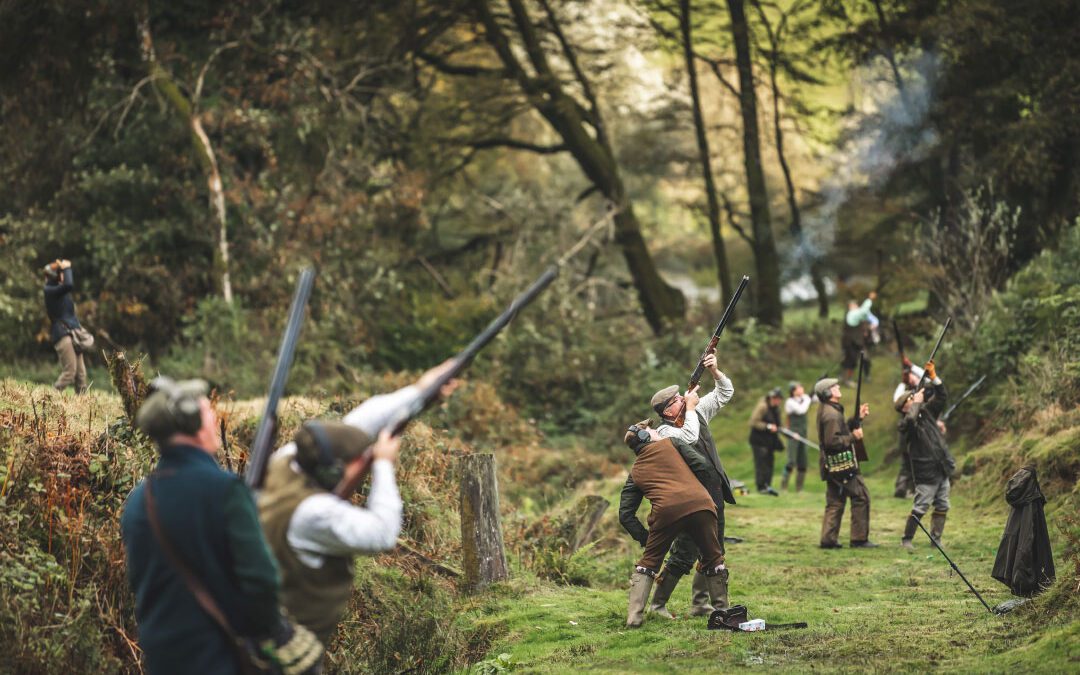A cloud of red-legged partridges surges down from the hilltop ahead, gray hurtling dots against a swirl of Devon sky, dozens of birds, a frantic scattergram of feathered rockets hell-bent astride a tailwind. Pick one, just one, push the barrels up and past, my back arched like a longbow to swing overhead through the shot, then again with the other barrel, grab the second gun Simon is nudging against my ribs, swing and swing again, switch guns once more and take a parting shot as the last speck in the partridge cloud sails past high, high, high above. Then breathe and do it again.
When a horn sounds to end the drive, the sudden silence feels like time reinserting itself into the day. The six of us who are the Guns on this shoot feel the earth again under our feet. We look up and down the line under a gentle fall of featherdown and watch the pickers-up and their dogs begin to work the cover behind us. We re-case our guns, pick up the empty shells and walk back for a cup of tea, a steaming mug of consommé-and-sherry, or a tot of sloe gin, and then we head on to the next drive through countryside too beautiful to be real.
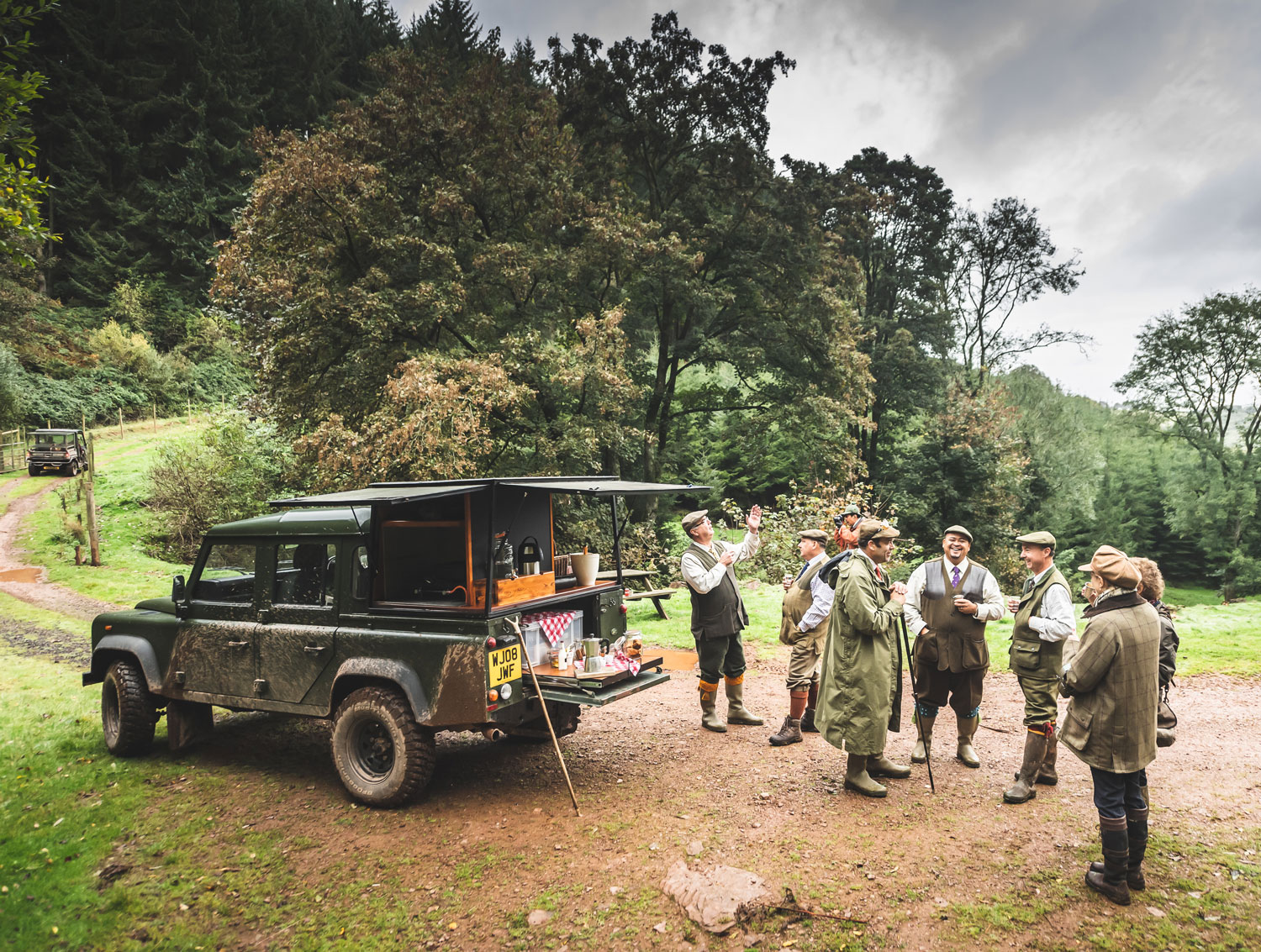
It is the changes of pace, of scenery, of activity among a community of 40 or more participants, each with an essential role, that make driven shooting feel so much like a well-conceived symphony. Every day in the field has its own music, the repetitions and variations that draw us into its patterns, make us part of whatever it may mean. Memories of the day will come from individual moments, but the joy of living now in those moments comes from living the symphony, one player amidst a grand convivium of landscape, weather, birds and the company we have chosen to keep.
I had long wanted to enjoy a great driven shoot in Britain, but for one reason or another I hadn’t made it happen until this past October. My old friend Dave Cruz, formerly of Holland & Holland and now heading his own company, Country Pursuits and Outfitters, called to tell me he was organizing a three-day shoot on Exmoor in North Devonshire and would Daphne and I like to join them?
That was an easy “Yes!” but what about guns? Dave said the host company, Loyton Sporting, which manages several of the best shooting estates in Devon, could supply them or I could bring my own, but if I wished I would be welcome to shoot any of the guns he had in stock.
As it happened, Dave had a couple of vintage Purdey 12 bores with nearly identical dimensions—not a true matched pair, but awfully close—so that was an easy “Yes!” too.
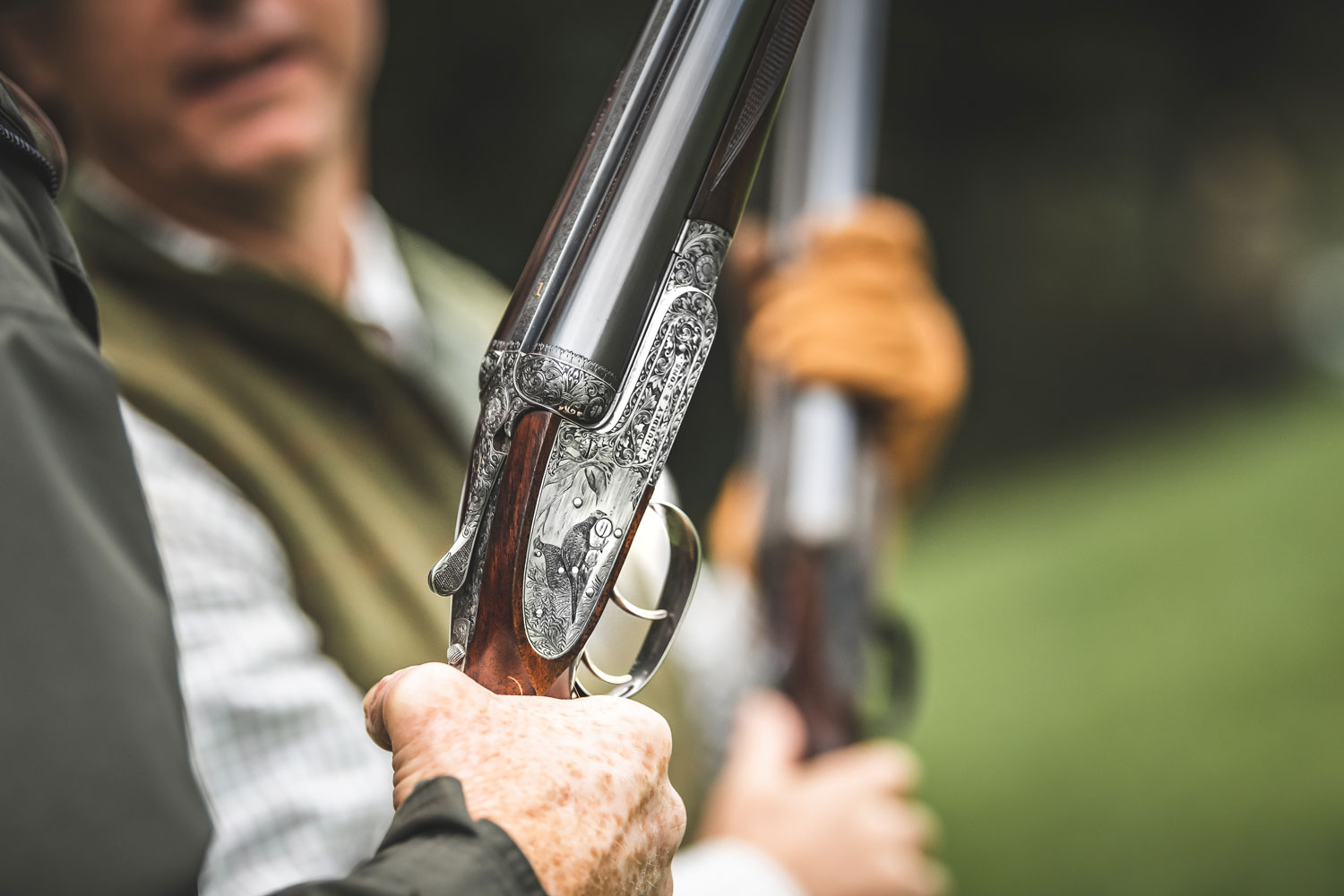
Dave sent the Purdeys down a month early so I could get used to them during our September dove season. They fit well, handled beautifully and dropped doves nicely, a good confidence-builder as the departure date for our trip approached. I wanted to try shooting a pair of guns with a loader, but I didn’t have an experienced loader available in Georgia, so Dave suggested that we book a day of expert instruction at the Holland & Holland shooting grounds near London on the day before we drove down to Devon. That turned out to be a really good idea.
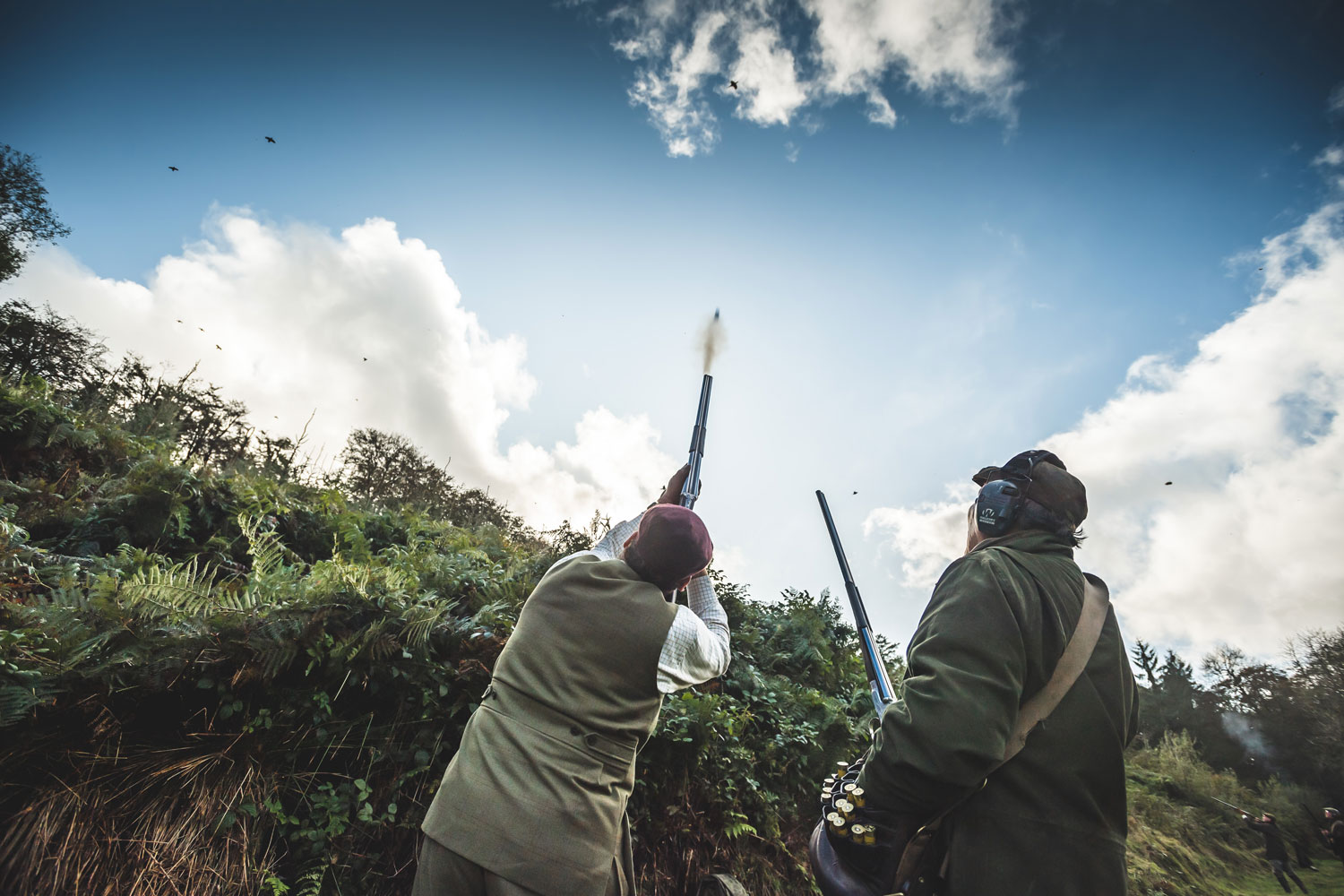
Jonathan Ward of Holland & Holland arranged an afternoon of high bird practice for us that provided an excellent sense of what we might expect to see during the actual shoot: fast, confusingly dispersed, high-flying targets in the 40-plus-yard range, with a bit of wind to make things extra-interesting.
Our instructors stressed the importance of moving our feet as the bird approached to anticipate paths and angles and, above all, to lead everything at least twice as much as we thought necessary. Great stuff and well worth the time and cost.
And so, after a pleasant day of shooting and shopping in London, our party of eight—six Guns and two of our spouses—made our way down the M5 on the three-hour drive to Devon where we found our hosts waiting at Molland House, a beautifully restored Victorian farmhouse that serves as one of Loyton Sporting’s two shooting lodges for the six estates it manages in the Exmoor area.
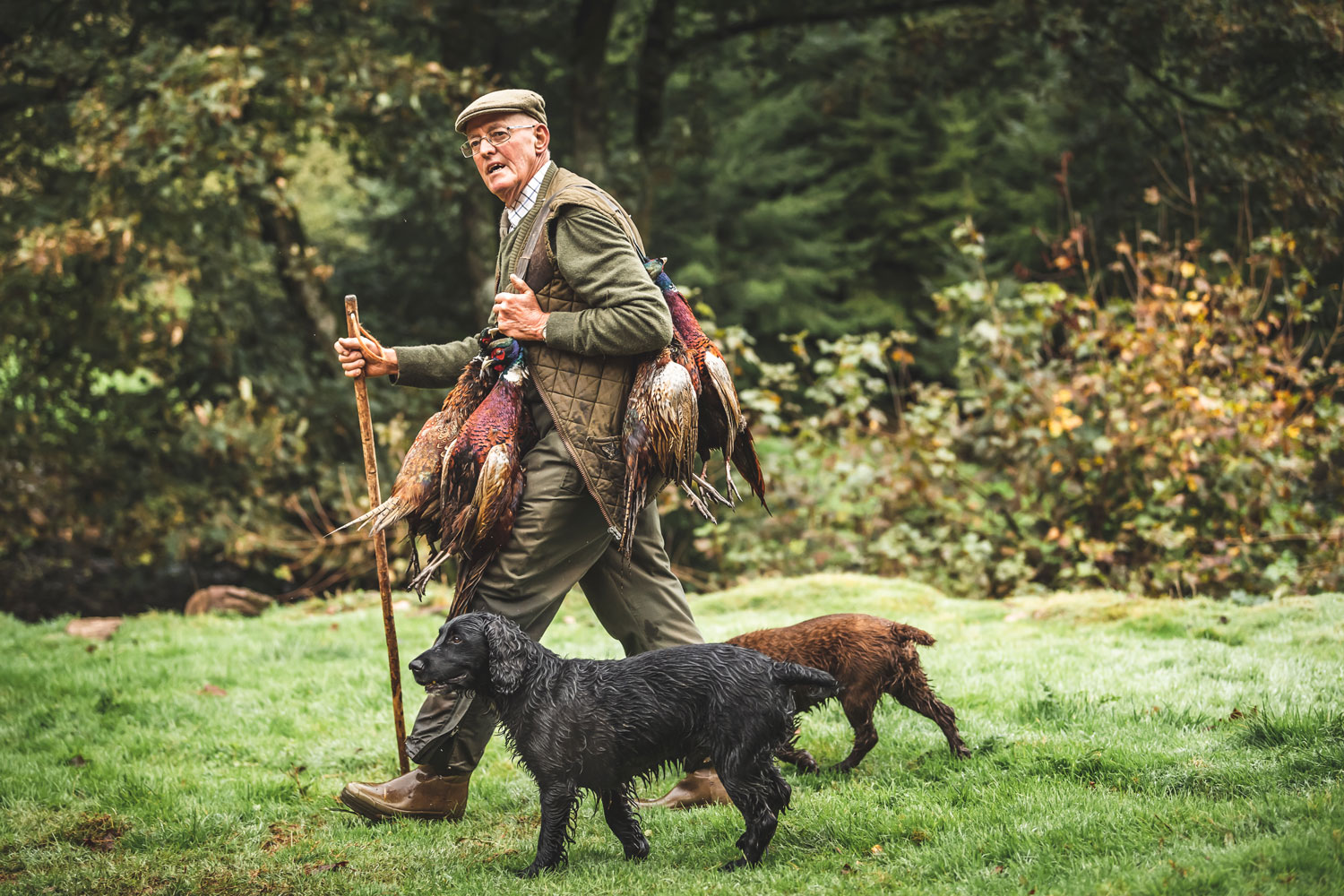
A local picker-up and his spaniel bring in a bag of pheasants. In England, driven shoots are a community affair.
The early autumn leaves showed a hint of gold above deep green pastures and newly trimmed hedges on the surrounding hills, and as the late-afternoon light faded into evening, we stowed our guns in the gunroom, met Henrietta Hare, who heads Molland House’s gracious and friendly staff, and enjoyed drinks and hors d’ouevres in the bar as we waited for dinner.
Molland House boasts 10 bedrooms (all with private baths), a comfortable bar/lounge, a lovely sitting room with fireplace and an invitingly elegant dining room. Our bedroom was spacious and nicely furnished, and the other members of our party seemed happy with their rooms as well. The food, prepared by Chef Dave Gobbett and his staff under the direction of Executive Chef Jean Christophe Le Grand, deserves special mention and was truly wonderful.
Each day began with a full English breakfast and ended with a superb dinner (game and lamb were featured during our stay) accompanied by well-chosen and excellent wines. Lunch was served at the shooting lodge on that day’s estate and for those who wished to remain at Molland House to pursue other activities, lunch and afternoon tea were served in the dining room.
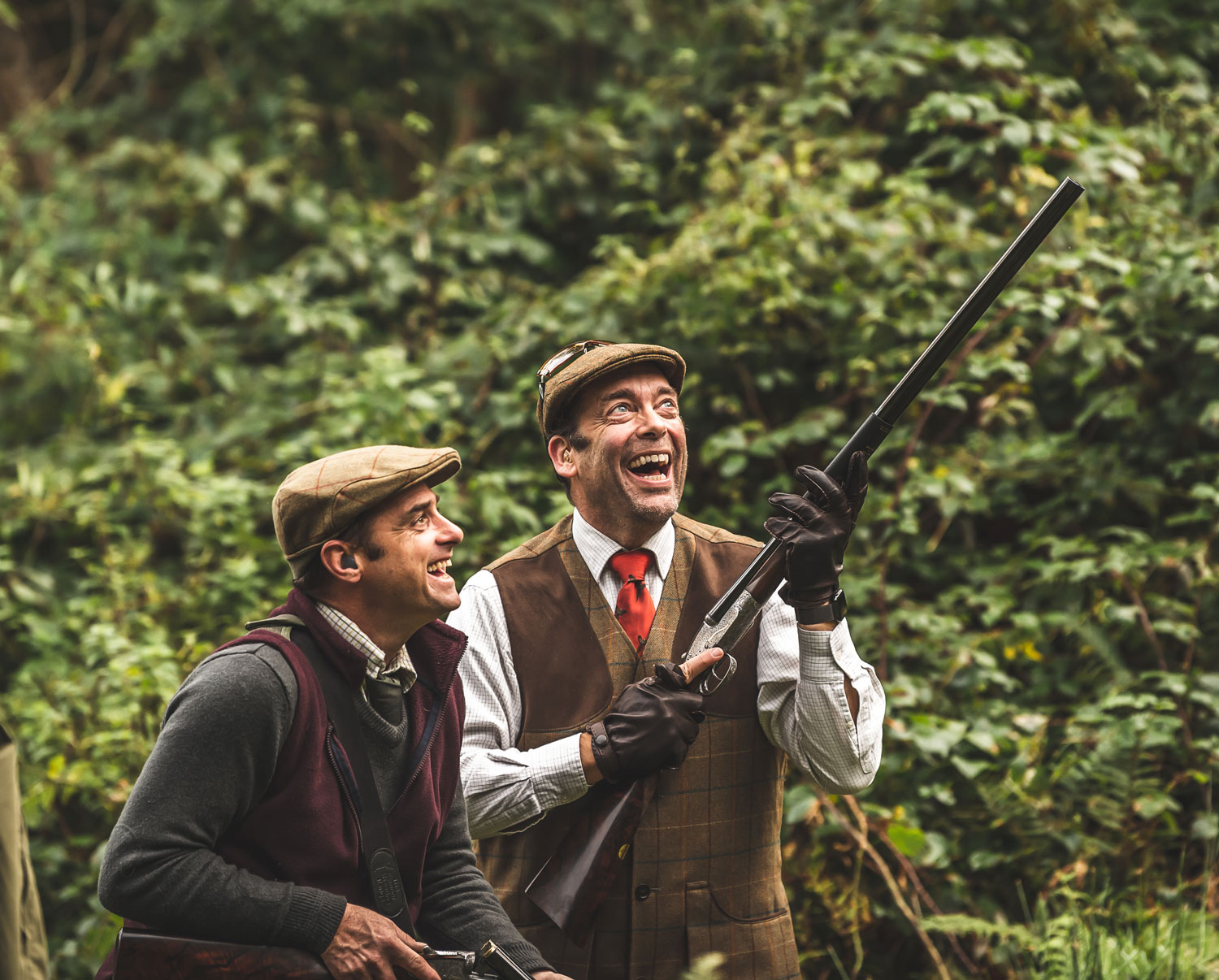
Food, in fact, was a dominant theme throughout our stay; we learned quickly that our hosts simply would not countenance even the slightest pang of hunger or thirst. Upon arrival at each day’s shooting estate and again between each drive we were served a seemingly endless variety of food and drink—coffee, tea, tipples of all kinds, soups, little sausage pastries that defied refusal, rabbit and other game on toast, to the point of bursting. All this was in addition to a splendid lunch between the third and fourth drives.
How the squires of old ever held up under the strain of near-daily shooting in such conditions I do not know, but I do admire their fortitude and appetite!
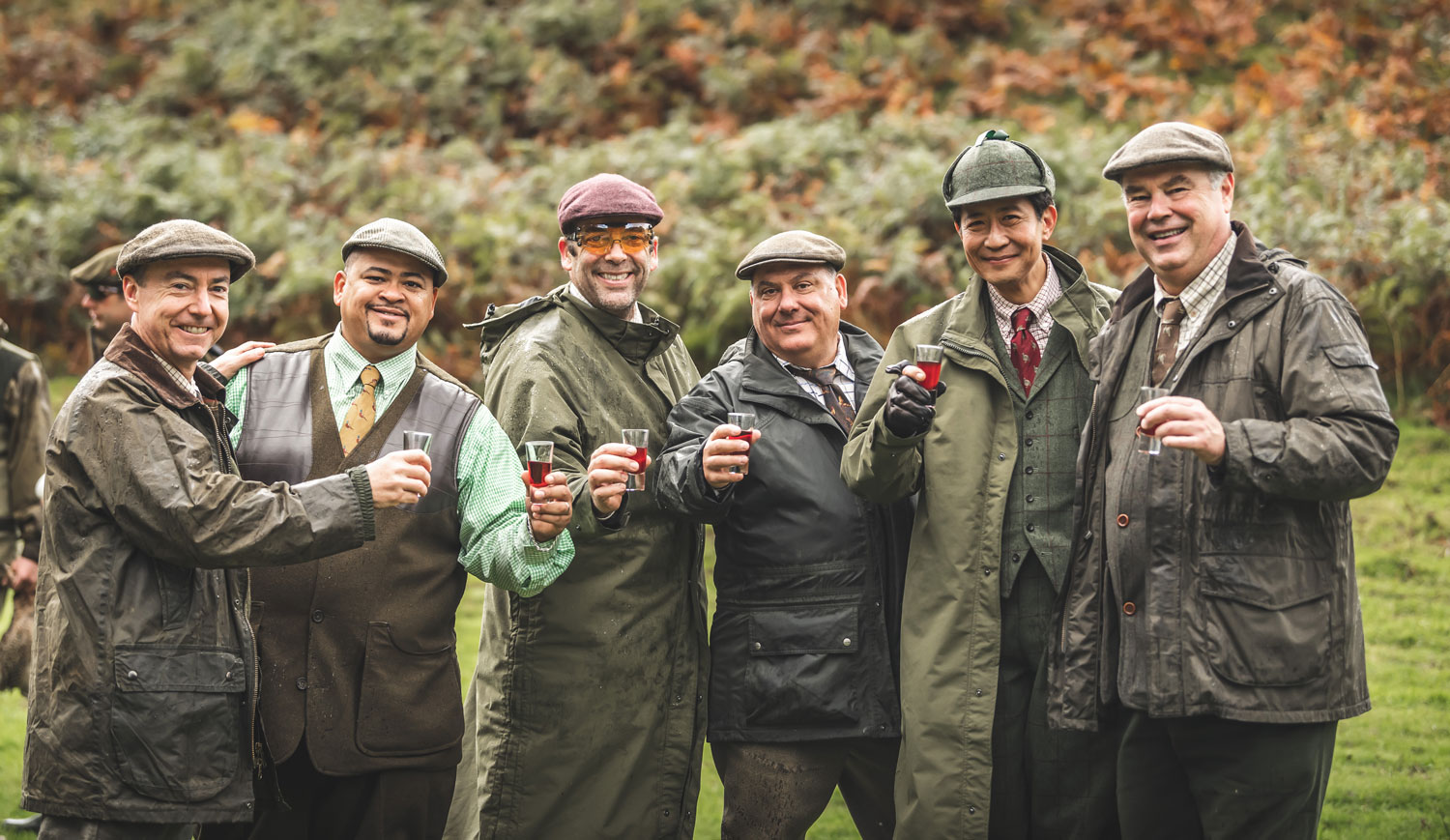
A touch of sloe gin to toast a fine drive. l-r: Bob Williams, Dave Cruz, Mike Woodbury, John Renaud, J. J. Park and Tony Perez.
In an odd but interesting way, the very surfeit of food seemed to have a tempering effect on the shooting itself. Driven shooting, after all, is not about the quantity of game shot; it is much more about the challenge of shooting well, striking just the right balance between gamebirds as game and as birds to be cherished, an essential feature of a beautiful countryside.
As one of our loaders put it, you should shoot the birds that give you pleasure: high, fast birds at whatever level of difficulty conveys to you a sense of achievement. It’s a form of manners, perhaps; or maybe it’s simply a way to find your own place in the day’s music.
Another key element of driven shooting is the varied presentation of birds across differing terrain. Each of the three estates we shot had its own particular character. Molland was lush rolling hills and splendid views, picture-book pretty. Combe Sydenham was high drama: rocks and tumbling water, tall forest, steeply hanging hills from which the birds emerged at nosebleed height. Edgcott was something between the two, a mixture of pastoral beauty and sudden transitions.
At each estate, each of the day’s four drives was carefully crafted to create its own challenges and aesthetics. In general, the line of Guns was situated low in a valley or “combe” facing a hill or ridgeline, which was sometimes forested and sometimes blanketed in bracken, hedgerows or other cover. The line of beaters worked through the cover toward the line from somewhere over the horizon, usually keeping entirely out of sight, moving with remarkable precision to push the birds from cover in just the right directions and at just the right pace to spread the shooting as evenly as possible among the Guns.
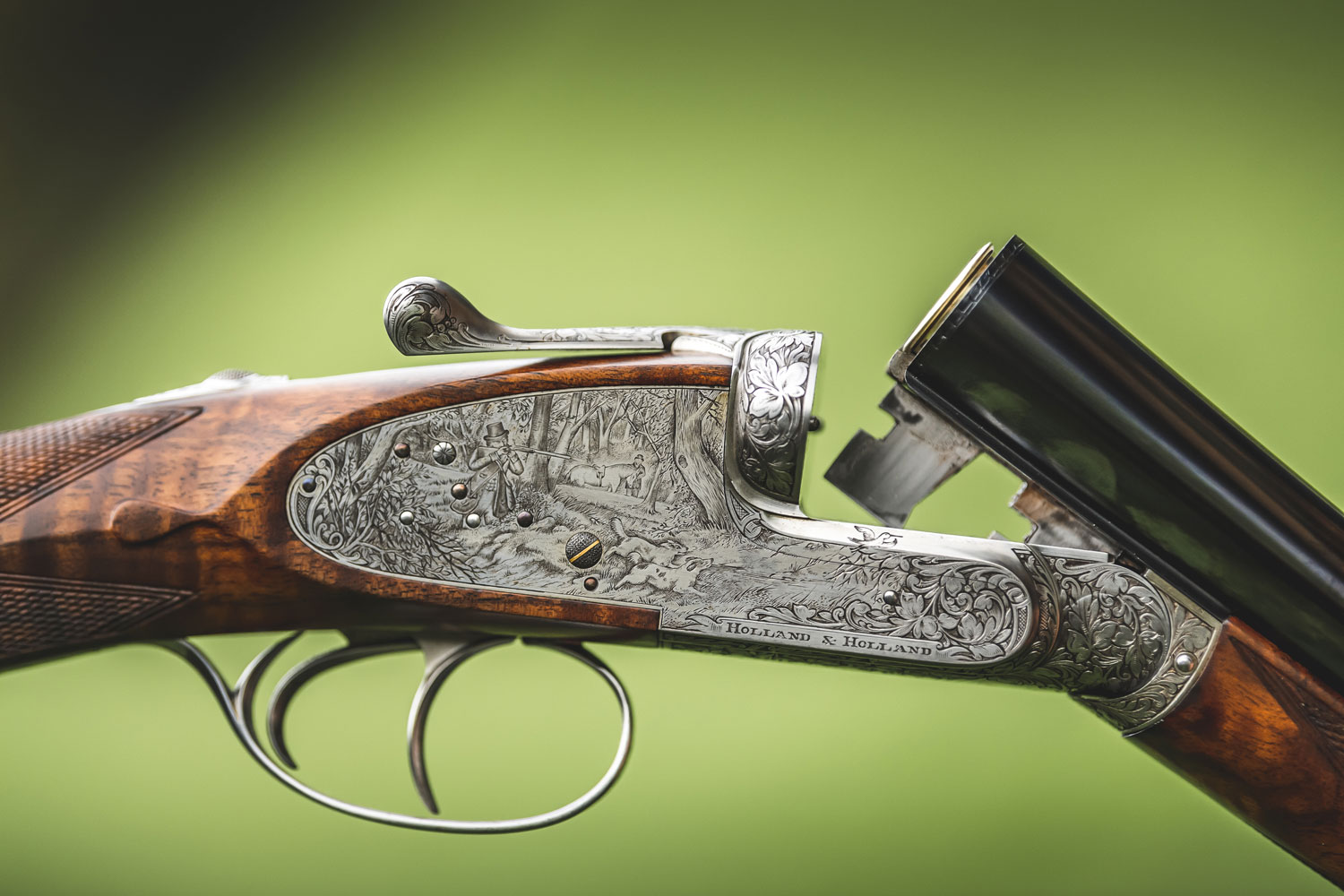
In the course of three days, I found my shooting tested from every conceivable angle, and that, of course, was the point of all the planning, training and coordination among the gamekeepers and beaters, many of whom have been putting on shoots over these grounds their entire lives.
Some drives stand out as especially memorable. For sheer drama, our third drive at Combe Sydenham, known as Holcombe Water, was hard to top. There, a mix of pheasant and partridge launched themselves from high forest down a steep gorge in which the Guns were placed along a stream, some on small bridges over waterfalls, giving the two Guns at the downstream end of the line some super-challenging 60- and 70-yard opportunities. I had a bird’s-eye view of Dave Cruz and John Renaud on the two pegs below me making a series of unbelievable shots that had them beaming like happy kids.
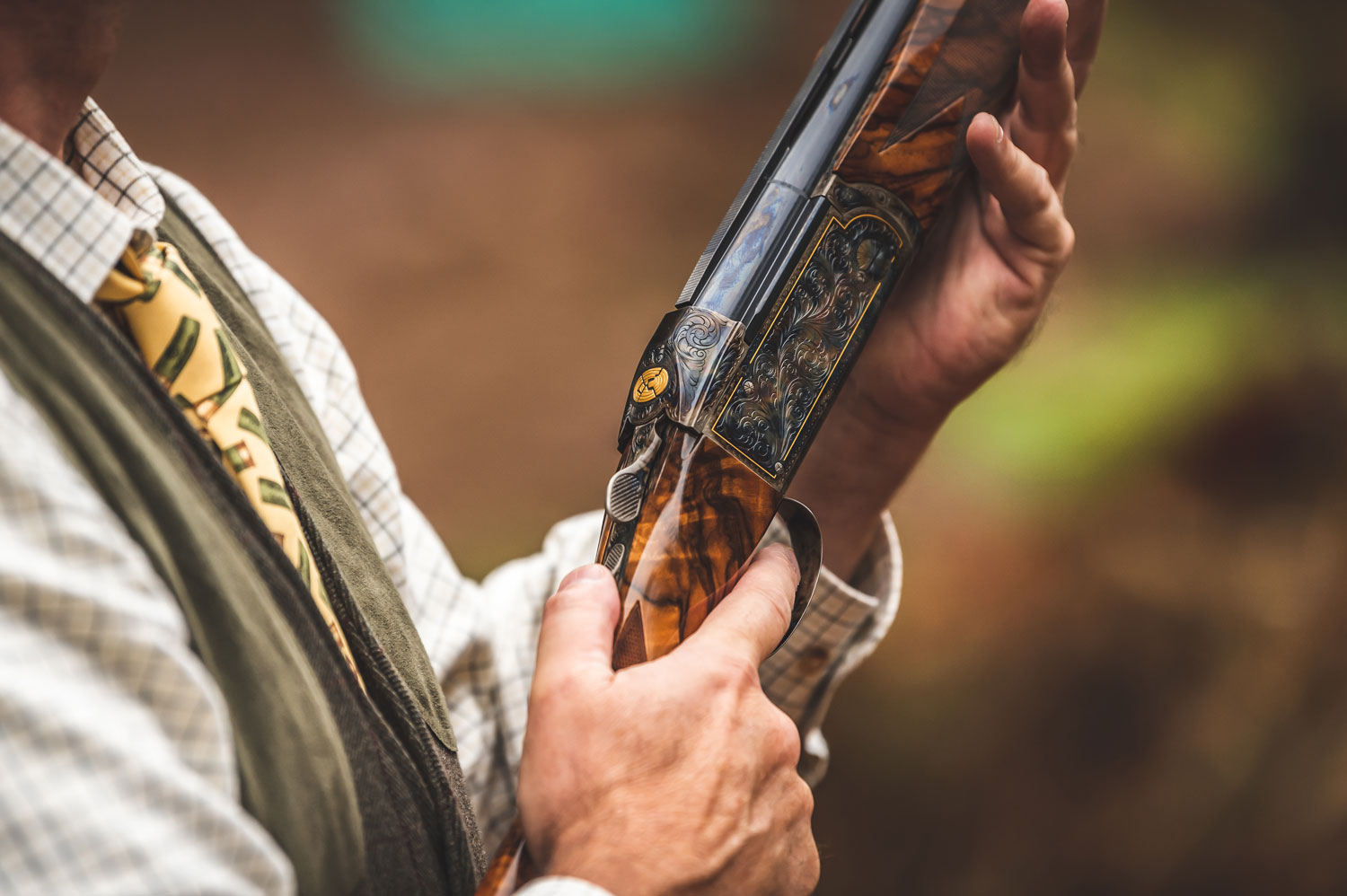
Having the right group of Guns and guests adds immeasurably to the fun, of course. This group was a mix of old friends and new with a remarkable variety of backgrounds: we hailed from Korea, Georgia, New Jersey, Florida, New York and Virginia; we had lawyers, an importer, a vintage firearms dealer, a retired marketing executive, a developer, a retired colonel and an English tea entrepreneur, all with a common love of living and laughing outdoors.
The shooting kept us busy, yet we always seemed to have an eye out for how things were going with the guys next to us. When someone happened to drop a spectacular bird, it wasn’t unusual to hear a cheer ripple down the line. And when an errant bird chanced to fall in someone else’s vicinity, we laughed at the cries of pretended outrage and good-natured invective.
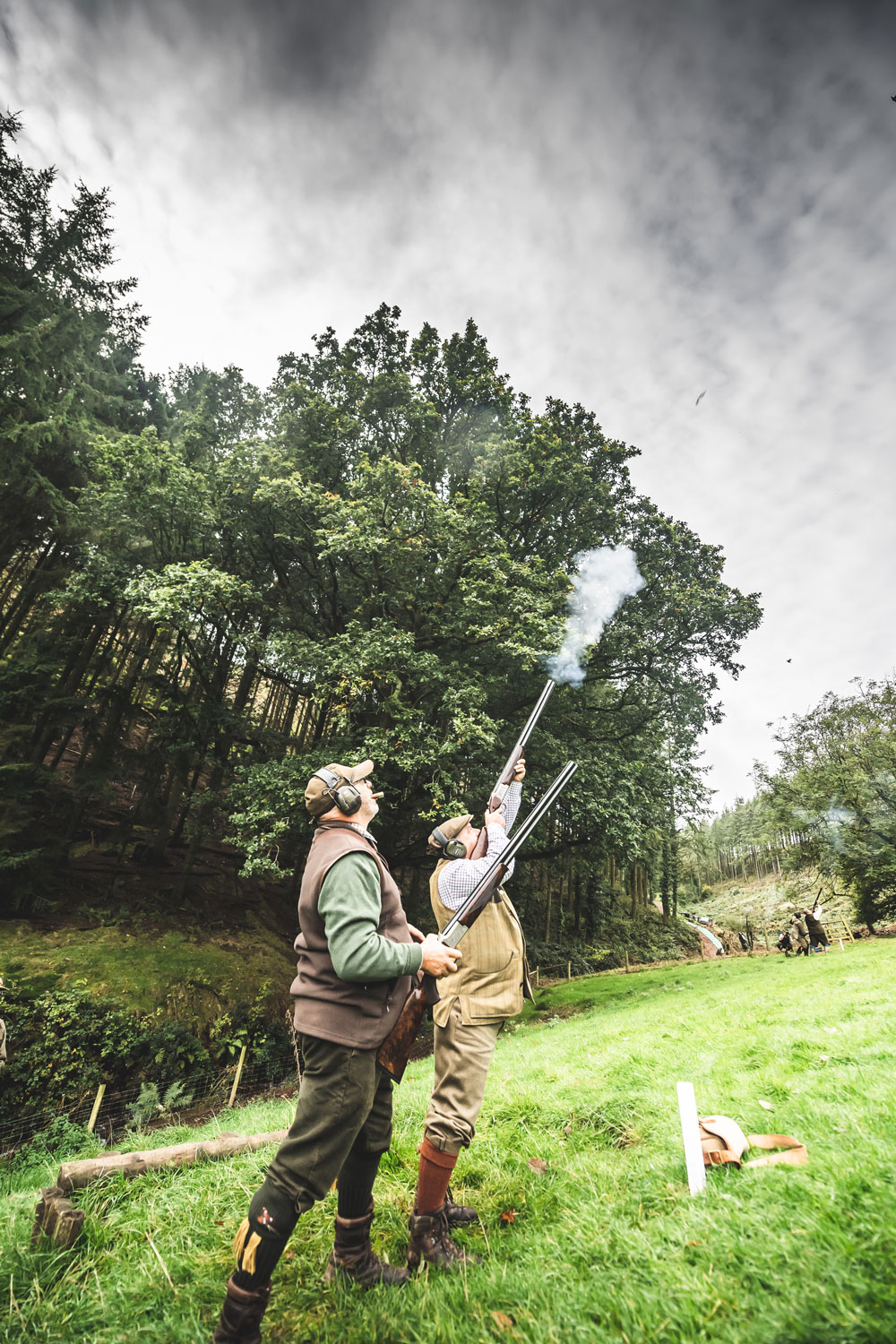
Throughout each day there was a lot of time for conversation walking to and from the drives, over lunch and during the breaks between drives. I learned a great deal about the finer points of putting on a shoot from the head gamekeepers at each estate—Robert “Spuddy” Cleave at Molland, Pete Conachie at Combe Sydenham and Nick Porter at Edgcott. Linley Williams, Edgcott’s owner, and Lawrence Wallace of Loyton Sporting were especially helpful in explaining the work involved in maintaining habitat, keeping the birds healthy throughout the year, and organizing the teams of gamekeepers, loaders, beaters, pickers-up and catering staff that are essential to a successful shoot. It is a complex, expensive and intensive operation that involves the entire surrounding community and that creates significant economic and non-economic benefits for Devon’s people and wildlife alike.
Shooting faces political pressure in the UK as in the U.S., perhaps even more so, but Loyton Sporting and its allies are working hard to spread the word about how their activities are enhancing the survival of both game and non-game species while creating jobs for local residents. It’s a story worth telling.
Loyton Sporting manages more than 30,000 acres on Exmoor, with extensive programs of crop rotation, cover improvement, plantings and beehives for pollinators, and other practices designed solely to benefit Devon’s wildlife. Introducing American shooters to Devon’s driven shooting opportunities is an important part of their long-term plan for assuring that the driven shooting tradition continues.
As soon as our group returned to the U.S. we began plans for another shoot in Devon next year. Having experienced the grand pageant of British driven shooting once, I cannot imagine leaving it at that. The elegant music of high birds, fine doubles, splendid food, good company and lovely manners is simply too compelling. If you’ve been, you know exactly what I mean; if you haven’t been yet, trust me about this, you need to go.
IF YOU WANT TO GO
Our trip was arranged through Loyton Sporting (loyton.com), which manages two lodges—Molland House, where we stayed, and Loyton Lodge, 30 minutes away, that serve the six shooting estates Loyton manages in England’s West Country, including the three estates covered in this article. Contact Angus Barnes at angus@loytonsporting.com or Piers Vaux at piers@loytonsporting.com. For guns and outfitting information, contact Dave Cruz at david@cpoutfitters.com.
WHAT TO BRING
British driven shooting requires British shooting attire. It’s part of the fun and it’s an important nod to traditions that are a huge part of our American sporting heritage. It rains a lot in Devon, so a British-styled waterproof jacket or cloak is a very good idea. For boots, Hunter, Le Chameau and Dubarry are all very popular. The good news is that proper attire is eminently practical—all those tweeds and caps and wellies will keep you as warm and dry as any high-tech ugly-as-sin substitute, and you’ll look much nicer. The even better news is that it doesn’t have to cost a fortune. Here are some websites to suit a variety of budgets:
William and Son
Upper price range. Beautiful stuff.
williamandson.com
James Purdey & Sons
Generally upper range, but they do have a wide selection, all of it of very high quality.
purdey.com
Holland & Holland
Generally upper range, not quite the selection that Purdey has and somewhat more fashion than field focused.
hollandandholland.com
Walker and Hawkes
Good quality and very reasonably priced. Lacks the exquisite tailoring of the more expensive brands, but very serviceable.
walkerandhawkes.co.uk
THE SHOTGUNS
A double, whether side-by-side or over-and-under, is essential. A pair is really fun, but not essential. Guns can often be rented, which saves having to travel with them. Chokes tend to be on the tight side, but anything from Improved Cylinder to Full will work. A 12 bore is standard and nice to have given the height of some of the birds, but many shooters enjoy 16- and 20-bore guns. Mike Woodbury brought a beautiful pair of Holland & Holland 20s on this trip and did very well with them. Dave Cruz shot a 12-bore Berretta and a 12-bore Holland & Holland, both over-and-unders, Tony Perez shot Kreighoff 12-bores, John Renaud shot Miroku 12-bores, J.J. Park shot one Holland & Holland and one Purdey, both 12-bore side-by-sides, and I shot a pair of Purdey 12-bore side-by-sides.
We all shot our share of birds and had a big time, suggesting that the important thing is to bring whatever gun makes you happiest. The guns I used, as well as several dozen other fine doubles, can be viewed at cpoutfitters.com.
This article originally appeared in the 2020 January/February issue of Sporting Classics Magazine.

